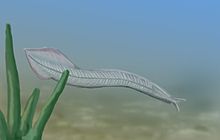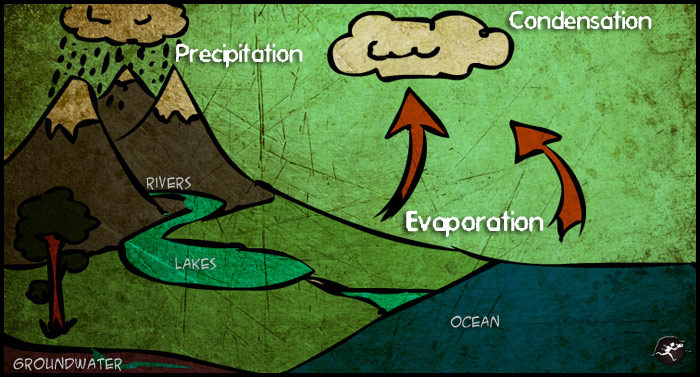Origins
The Earth as we know it contains a stunning array of life. From bubbling geothermal vents deep in the ocean to tropical rain forests, life has evolved to cover every nook and cranny on Earth’s surface. It’s hard to imagine our planet without this diversity of life; as a surface only covered with bare rock and water, but for a very long time that is all Earth was.
Thanks to Charles Darwin (ecogeek) and Alfred Russel Wallace (the forgotten ecogeek), we know that evolution by natural selection was the mechanism by which life was able to become so diverse. Exactly how and when life originally formed, however, is still being debated and will likely be debated for a long time. First of all, nobody was there to witness it, and the information that was recorded in the rocks is difficult for scientists to decipher. But we do know that it happened!
In the beginning…
Earth 4.6 billion years ago was not a pleasant place to be. It had just been formed, and it was still mostly molten rock that had not yet separated into the core, mantle and crust as we know it. It was constantly being hit with asteroids and huge volcanoes and fissures on the surface were belching lava, water vapor and toxic gasses. This is called the Hadean Eon from the Greek word Hades which means ‘underworld’.
Over the next 600 million years, though, the hot molten rocks began to separate and form the iron core, mantle and a crust that finally began to cool and harden. The volcanoes that had been erupting for hundreds of millions years had put a lot of water vapor into the atmosphere. When the Earth was finally cool enough, that water vapor began to condense and rain down on Earth, forming the oceans. At this time in Earth’s history, there wasn’t much dry land and oceans covered almost everything. The atmosphere was mostly carbon dioxide, nitrogen and water. Conditions were ripe for some life-making.
Creation
The first thing you have to remember about the origins of life is that it was not some quick magic trick that the Earth pulled off. It was a very gradual process of shuffling and recombining basic molecules until they became more and more complex. These complex molecules then needed to replicate themselves “on purpose” and have a built in genetic code that was able to construct bigger molecules from scratch. Then, it needed to encase itself somehow in a semi-permeable membrane. The fact that this happened at all is a miracle, but it did!
The most probable explanation for this, without getting into specific chemistry, is: The basic molecules that existed on early Earth (nitrogen, water, carbon dioxide, methane) were able to use energy from deep sea vents, lightning, or the ultraviolet radiation from the sun to create more complex organic molecules like sugars, amino acids and fatty acids. Laboratory experiments performed by A.I. Oparin and Stanley Miller have shown that given the right circumstances it is possible to form complex organic molecules from basic inorganic ingredients.
Once these molecules were formed they then needed to become concentrated enough to form extra large molecules like nucleic acids and sugars, the building blocks of RNA and DNA. Certain areas, like deep sea vents or areas with high concentrations of clay minerals have been known to naturally concentrate these organic molecules. RNA was most likely formed before DNA, because it is able to replicate itself without too much help (DNA needs a lot of help to replicate… mostly from RNA). If RNA was formed first, it would then begin to replicate itself and begin making proteins from amino acids. Over time, the RNA strands along with the proteins they produced would be able to make a double stranded DNA molecule capable of replication.
If a DNA strand was then encased in a fatty membrane we could technically call this a cell. Laboratory experiments have shown that a fatty membrane with small amounts of DNA and proteins is subject to osmosis. Water would rush in to balance the concentration of solute inside and outside the cell and as DNA kept replicating, more water would rush in and the fatty membrane would eventually split. Primitive cell replication!
The Familiar
With all the requirements of life being filled, early cells would be subject to natural selection, eventually producing bacteria. The oldest types of bacteria that are still around today are called Archaebacteria, followed by Eubacteria. Together, these two categories make up the two domains of living things. Every living thing on Earth can trace their lineage all the way back to these two basic types of organisms!
Improbable? Yes. Impossible? No.
As we have said, the fact that any of this even happened is a miracle. Or is it? Think of it this way, the Earth was formed approximately 4.6 billion years ago. Evidence for very primitive forms of life like archaebacteria arose about 4 billion years ago. That leaves 600 million years for all this to take place. In that amount of time even very improbable things can happen, especially if each successful step increases the probability of success for the next step.
Lets say you buy a lottery ticket with a one and a hundred million chance of winning. Stupid move right? Now lets say every time you win even a little bit of money, your chances of winning the next time you buy a ticket go up. Now go buy a lottery ticket every day for 600 million years. Do you think you will win the Jackpot?
“There is grandeur in this view of life, with its several powers, having been originally breathed into a few forms or into one; and that, whilst this planet has gone cycling on according to the fixed law of gravity, from so simple a beginning endless forms most beautiful and most wonderful have been, and are being, evolved. “- Charles Darwin



 Diatoms are microscopic, pill-box shaped plants that inhabit all the oceans on earth. Diatoms are special in that they are capable of building shells, called frustules, out of glass! Each species has a very unique shape and can be very beautiful under a microscope. The majority of diatoms are unicellular, meaning they exist as only one cell, but some species are colonial and live in large chains of unicellular phytoplankton.
Diatoms are microscopic, pill-box shaped plants that inhabit all the oceans on earth. Diatoms are special in that they are capable of building shells, called frustules, out of glass! Each species has a very unique shape and can be very beautiful under a microscope. The majority of diatoms are unicellular, meaning they exist as only one cell, but some species are colonial and live in large chains of unicellular phytoplankton.






























































































